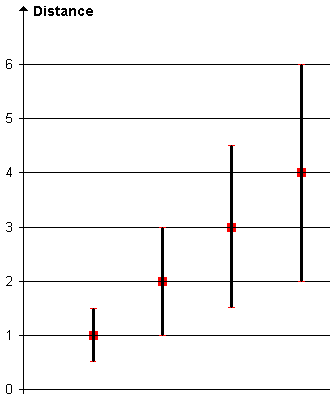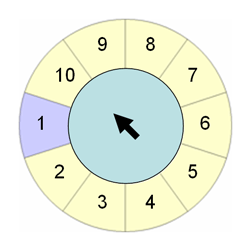Succeeding the Tog Test...
By Gerd Waloszek
To overview of UI Design Issues
Recently, a colleague of mine attended a workshop from the Nielsen Norman group in London where she took part in a tutorial held by Bruce Tognazzini, or Tog, for short. Among others, Tog presented Fitts' law and was eager to mention that he probes job applicants on this law (as you can imagine, if you fail the "Tog test" you can forget working for the NN group...).
My colleague had not heard of Fitts' law before and was curious to know whether she was the only one with this gap in her knowledge. Back at work, she probed her colleagues for Fitts' law in a team meeting. None of them had heard of it either – even those with a background in psychology. Then she asked me. Yes, I had heard of the law but what I recalled was something different, namely Hick's law. That should be reason enough to offer a short refresher of Fitts' law.
Fitts' Law
According to Wikipedia, "Fitts' law still remains one of the few hard, reliable predictive models in human-computer interaction." In short is says:
- The time to acquire a target is a function of the distance to and width of the target (formulation by Tog, adapted)
I do not want to bother you with the exact formula. You can find it, together with more details, in Wikipedia. Fitts published his law in two articles (Fitts, 1954; Fitts and Peterson, 1964); the formula is best know in the "Shannon" formulation proposed by Scott and McKenzie.
Note: The target width (Tog calls it "size") is measured along the axis of motion. It can also be conceived as the "allowed error tolerance in the final position."

Figure 1: Fitts' law states that in order to achieve the same movement time, target width has to be increased according to the distance of the target
Restrictions
In the 1980s, Fitts' law was extended graphical user interfaces. Here, the users' task is to move the mouse cursor and position it over an on-screen target, such as a button (Fitts' law can model both point-and-click and drag-and-drop actions). In its original and strictest form, however, the law:
- Applies only to movements in a single dimension
- Describes simple motor responses – it does not account for software acceleration usually implemented for a mouse cursor
- Describes untrained movements
The first restriction was dealt with in the in the Accot-Zhai steering law, which extends Fitts law to two dimensions.
Applying Fitts' Law
But what is the use of a law if we cannot apply it? Therefore, we had better assume that it is also valid for pointing with the mouse. According to Wikipedia, some consequences for user-interface design include:
- Buttons and other controls to be selected in GUIs should be a reasonable size; it is very hard to click small targets.
- Edges and corners of the computer display are easy to reach because the pointer is "caught" at the edges, irrespective of how much further the mouse is moved (they can be considered as having infinite width). There is no danger of "overshooting," which requires corrective movements that cost time.
- Popup menus can usually be opened faster than pull-down menus, since the user avoids movement.
- Pie menu items are typically selected faster and have
a lower error rate than linear menu items, for two reasons:
- Menu items are all the same, small distance from the center of the menu
- Their wedge-shaped target areas (which usually extend to the edge of the screen) are very large
In the past, Tog liked to tell the story of why the Apple Macintosh menu solution is superior to the window menus in Windows. On the Mac, there is only one menu bar at the top edge of the screen, which reflects the active application. In Windows, however, each window has a menu bar of its own. Because the Mac menu bar is at the edge of the screen, menu items can be selected much faster than in Windows – you simply "slam" the cursor against the edge of the screen. In the course mentioned above, however, Tog seems to have forgotten this story...
Popup menus, such as context menus, which are opened with the right mouse button, have the additional advantage that functionality can be offered not only "in-place" but also selectively. I called this the "locality" principle. However, popup menus, which are opened using small trigger icons, are not a good design choice, at least seen from a Fitts' law perspective. Also note that Fitts' law tells us that the usual linear popup menus are not optimal – pie menus are better. However, the only pie menu that I know of is offered by the Logitech mouse driver (see figure 2; note that the menu items do not extend to the edge of the screen). I must admit that I have never used it.

Figure 2: Pie menu
A Word of Caution...
Please note, that typical reaction times at the computer are the result of a complex interplay of different, often competing, influences – Fitts' law is just one of them.
More to Come...
I a follow-up article, I will briefly present Hick's law, another HCI "classic," its applications, and also the power law of practicw.
References
- Wikipedia: Fitts' law
- Wikipedia: Accot-Zhai steering law
- Paul M. Fitts (1954). The information capacity of the human motor system in controlling the amplitude of movement. Journal of Experimental Psychology, volume 47, number 6, June 1954, pp. 381-391. (Reprinted in Journal of Experimental Psychology: General, 121(3):262-269, 1992).
- Paul M. Fitts and James R. Peterson (1964). Information capacity of discrete motor responses. Journal of Experimental Psychology, 67(2):103-112, February 1964.
- Johnny Accot and Shumin Zhai (1997). Beyond Fitts' law: models for trajectory-based HCI tasks. Proceedings of ACM CHI 1997 Conference on Human Factors in Computing Systems, pp. 295-302.
- Stuart K. Card, Thomas P. Moran, Allen Newell (1983). The Psychology of Human-Computer Interaction.
- More references can be found in the above-mentioned Wikipedia articles
Originally Published: 06/07/2006 - Last Revision: 10/31/2009
Gerd Waloszek |
made by |
